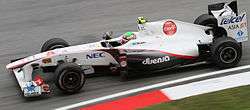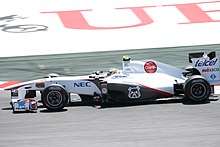Sauber C30
The Sauber C30 is a Formula One racing car developed by Sauber Motorsports for use in the 2011 Formula One season. As with the Sauber C29 the car is powered by a Ferrari engine, but with added capability to house Ferrari's customer KERS system.
 | |||||||||||
| Category | Formula One | ||||||||||
|---|---|---|---|---|---|---|---|---|---|---|---|
| Constructor | Sauber | ||||||||||
| Designer(s) | James Key (Technical Director) Christoph Zimmermann (Chief Designer) Seamus Mullarkey (Head of Aerodynamics) | ||||||||||
| Predecessor | Sauber C29 | ||||||||||
| Successor | Sauber C31 | ||||||||||
| Technical specifications[1] | |||||||||||
| Chassis | carbon-fibre and honeycomb composite monocoque | ||||||||||
| Suspension (front) | Upper and lower wishbones, inboard springs and dampers, actuated by Sachs pushrods | ||||||||||
| Suspension (rear) | as front | ||||||||||
| Engine | Ferrari Type 056 2,398 cc (146.3 cu in) 90° V8, limited to 18,000 RPM with optional 60 kW (80 hp) KERS naturally aspirated mid-mounted | ||||||||||
| Transmission | Seven-speed semi-automatic carbon-fibre sequential gearbox with reverse gear electronically-controlled, quick-shift Limited-slip differential | ||||||||||
| Weight | 640 kg (1,411 lb) (including driver) | ||||||||||
| Fuel | Shell | ||||||||||
| Tyres | Pirelli P Zero OZ Wheels (front and rear): 13" | ||||||||||
| Competition history | |||||||||||
| Notable entrants | Sauber F1 Team | ||||||||||
| Notable drivers | 16. 17. 17. | ||||||||||
| Debut | 2011 Australian Grand Prix | ||||||||||
| |||||||||||
After running a near-blank livery in 2010, the team has acquired several sponsors including Jose Cuervo, and has had an investment from Telmex owner Carlos Slim. Some 2010 sponsors, including Mad Croc Energy, have returned. The car was driven by Kamui Kobayashi and Mexican newcomer Sergio Pérez. The car was unveiled on 31 January 2011 at the Circuit Ricardo Tormo in Valencia, Spain.[2] On the following day, Kobayashi became the first driver to test the car.[3]
Season review

At the first race in Melbourne, both Pérez and Kobayashi scored points, finishing in 7th and 8th place respectively, scoring a total of 10 points. However, following the discovery of a non-regulation rear wing, both cars were disqualified and their points were redistributed.[4]
Unlike the 2010 C29 the C30 was reliable from the start of the season and developments have come at a respectable rate, keeping it easily within the top 10. Kobayashi finished in the top 10 in the first seven races, and amassed 25 points - including a fifth at Monaco, and a seventh in Canada after running in second at the restart. Sergio Pérez was forced to retire in Malaysia when a piece of a Toro Rosso flew off and sliced his car. In the Spanish Grand Prix, Pérez scored his first points, with ninth, and in the next race, he crashed in Q3 in Monaco, injuring him badly enough so that he had to miss the Monaco and subsequent Canadian Grand Prix where former Sauber driver Pedro de la Rosa took his seat and finished twelfth.
The next ten races were not so successful for Kobayashi only having one points finish - in Germany. Pérez scored his best race result, in Britain, finishing seventh; before he was robbed of an equal result in Monza where both cars retired with gearbox failures. This put Force India ahead of them in the Constructors' Championship, into sixth place. Pérez got back into the points in Singapore, with tenth place, but this was nothing compared to the twelve points Force India scored at that race. At the Japanese Grand Prix Kobayashi impressed his home fans by going fastest in Q1 and qualifying a career best seventh. When Kobayashi had a not so successful race, Pérez made advantage of making one less pit stop, finishing an impressive eighth. Kobayashi re-captured his form when he finished the last two races in a points scoring finish, tenth in Abu Dhabi and 9th in Brazil. In total, they accumulated the same number of points as the previous season's Sauber C29.
Continued use after Formula One
The Sauber C30 forms the basis of the Heritage F1 HF1-018 which uses the Sauber designed C30 chassis, front suspension and aerodynamic devices. The HF1-018 is advertised as the fastest track day car in the world and is powered by a small capacity turbo charged engine similar to that used in the 2014 onwards Formula One championship but does not use a KERS system as the original C30 did. According to the Heritage F1 website the HF1-018 was constructed by the UK based motorsport engineering company TDF.
The HF1-018 made its debut in May 2018 at Circuit Zolder as part of a FORCE F1 demonstration. The car has since featured in numerous television adverts, press adverts and F1 demonstrations, most recently at the 2018 Silverstone Classic where it was driven by Oliver Webb and Jessica Hawkins. In June 2018, Billy Monger drove a Formula One racing car for the first time when he tested the HF1-018 at the Rockingham Motor Speedway in Corby. The car had been specially converted to match the hand controls present in the Carlin BRDC British Formula 3 car he races. A documentary feature about Monger's first Formula One drive was shown as part of Sky F1's coverage of the 2018 Austrian Grand Prix. During the 2019 Chinese Grand Prix race weekend, Jessica Hawkins drove a special livery HF1-018 (also known as F1-1000, to celebrate the 1000th F1 championship race) as a part of the F1 Shanghai Festival 2019 - F1 live roadshow.
Complete Formula One results
(key) (results in bold indicate pole position; results in italics indicate fastest lap)
| Year | Entrant | Engine | Tyres | Drivers | 1 | 2 | 3 | 4 | 5 | 6 | 7 | 8 | 9 | 10 | 11 | 12 | 13 | 14 | 15 | 16 | 17 | 18 | 19 | Points | WCC |
|---|---|---|---|---|---|---|---|---|---|---|---|---|---|---|---|---|---|---|---|---|---|---|---|---|---|
| 2011 | Sauber F1 Team | Ferrari 056 V8 | P | AUS | MAL | CHN | TUR | ESP | MON | CAN | EUR | GBR | GER | HUN | BEL | ITA | SIN | JPN | KOR | IND | ABU | BRA | 44 | 7th | |
| Kobayashi | DSQ | 7 | 10 | 10 | 10 | 5 | 7 | 16 | Ret | 9 | 11 | 12 | Ret | 14 | 13 | 15 | Ret | 10 | 9 | ||||||
| Pérez | DSQ | Ret | 17 | 14 | 9 | DNS | PO | 11 | 7 | 11 | 15 | Ret | Ret | 10 | 8 | 16 | 10 | 11 | 13 | ||||||
| de la Rosa | 12 |
References
- "C30 Data". Sauber F1 Team. Sauber Motorsport. Archived from the original on 7 February 2011. Retrieved 5 February 2011.
- Elizalde, Pablo (2010-12-03). "Sauber announces 2011 car launch date". Autosport.com. Haymarket Publications. Retrieved 2010-12-03.
- Collantine, Keith (2011-01-29). "Driver line-up set for first F1 test of 2011". F1 Fanatic. Keith Collantine. Retrieved 2011-01-31.
- Elizalde, Pablo (27 March 2011). "Sauber duo disqualified from Australia". Autosport. Haymarket Publications. Retrieved 27 March 2011.
External links
| Wikimedia Commons has media related to Sauber C30. |
- Sauber C30 Engineering & Materials (official site)
- About the Heritage HF1-018 car (official site)